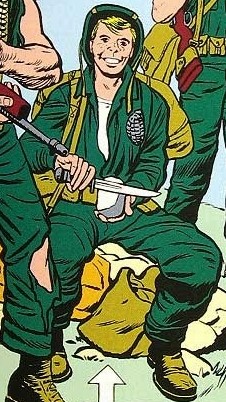
Colonel Nicholas Joseph "Nick" Fury Sr. is a fictional character appearing in American comic books published by Marvel Comics. Created by writer/artist Jack Kirby and writer Stan Lee, he first appeared in Sgt. Fury and his Howling Commandos #1, a World War II combat series that portrayed the cigar-chomping man as leader of an elite U.S. Army Ranger unit.

Commando For Action and Adventure, formerly known as Commando War Stories in Pictures, and colloquially known as Commando Comics, is a British comic book magazine that primarily draws its themes and backdrops from the various incidents of the First and Second World Wars. It was first published in July 1961 and is still in print today. It is noted for its distinctive 7 × 5½ inch, 68 page format that became a standard for these kinds of stories. "Commando" has remained more popular than many other British war comics, because of its character based stories and detailed black and white artwork, with only the covers in colour. It is considered by some to be one of the greatest war comics in history.
Tharg the Mighty or The Mighty One is the fictional editor of the British science fiction comic 2000 AD. The character was introduced on the cover of the first issue in 1977 and is one of only two characters to appear in almost every issue of the comic, the other being Judge Dredd. Tharg rarely appears in stories but strips involving him have been written by such notable writers as Alan Grant, Alan Moore and John Wagner, albeit usually credited to "TMO" – "The Mighty One".

Sgt. Fury and his Howling Commandos is a comic book series created by Jack Kirby and Stan Lee and published by Marvel Comics from 1963 to 1981. The main character, Sgt. Nick Fury, later became the leader of Marvel's super-spy agency, S.H.I.E.L.D. The title also featured the Howling Commandos, a fictional World War II unit that first appeared in Sgt. Fury and his Howling Commandos #1.

Sgt. Franklin John Rock is a fictional character appearing in American comic books published by DC Comics. Sgt. Rock first appeared in Our Army at War #83, and was created by Robert Kanigher and Joe Kubert. The character is a World War II soldier who served as an infantry non-commissioned officer.

Captain Midnight is an American adventure franchise first broadcast as a radio serial from 1938 to 1949. The character's popularity throughout the 1940s and into the mid-1950s extended to serial films (1942), a television show (1954–1956), a syndicated newspaper strip, and a comic book title (1942–1948).

Battle Picture Weekly was a British weekly boys' war comic published by IPC Magazines from 8 March 1975 to 23 January 1988, when it merged with the new incarnation of Eagle after 644 issues. Most stories were set in World War II, with some based on other conflicts, while factual features also focused on warfare.

Bulletman and Bulletgirl are fictional superheros originally published by Fawcett Comics.

Union Jack is the name of three fictional superheroes appearing in American comic books published by Marvel Comics. Created by Roy Thomas and Frank Robbins, the first Union Jack first appeared in Invaders #7. A second incarnation from the same creators appeared in The Invaders #21, and a third incarnation was created by Roger Stern and John Byrne for Captain America Vol. 1 #254.

Spitfire is a fictional superheroine appearing in American comic books published by Marvel Comics. Created by Roy Thomas and Frank Robbins, the character first appeared in the Invaders comic book series as an intended replacement for the Union Jack character, but the costume design did not fit the female torso. Instead, the character of Spitfire, named after the Supermarine Spitfire fighter plane, was created.

Minute-Man is a superhero appearing in comics published Fawcett Comics and later DC Comics.
Phantom Eagle is the name used by two fictional aviator heroes appearing in American comic books.

Harry "Tex" Thompson is a superhero owned by DC Comics who later became the masked crime-fighter Mr. America and then became an espionage operative called Americommando. He was often aided by his best friend Bob Daley, who for a brief time operated as his costumed sidekick "Fatman". Created by Ken Fitch and Bernard Baily, Tex debuted in Action Comics #1, the same comic that introduced Superman. During his original stories of the 1940s, several of his enemies were based on Yellow Peril stereotypes. Several of his earliest stories featured Gargantua T. Potts, a character based around minstrel show stereotypes about African-Americans.

Jonathan "Junior" Juniper is a fictional character appearing in American comic books published by Marvel Comics. Created by Stan Lee and Jack Kirby, his first appearance was in Sgt. Fury and the Howling Commandos vol. 1 #1. He is known to be the first major character death in a Marvel comic and the only Howling Commando ever to die in battle.

Percival "Pinky" Pinkerton is a fictional character appearing in American comic books published by Marvel Comics. The character's first appearance was in Sgt. Fury and his Howling Commandos #8, in which he replaced Jonathan Junior Juniper who was killed in issue #4. He was created by writer Stan Lee and artist Jack Kirby.

Bullet was a comic book published weekly in the UK during the 1970s.

The Hotspur was a British boys' paper published by D. C. Thomson & Co. From 1933 to 1959, it was a boys' story paper; it was relaunched as a comic in October 1959, initially called the New Hotspur, and ceased publication in January 1981.

The Destroyer is the name of three fictional superheroes appearing in American comic books published by Marvel Comics. The original incarnation was created by writer Stan Lee and artist Jack Binder and first appeared in Mystic Comics #6, being one of Lee's earliest creations during the Golden Age of Comic Books.















